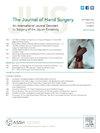Altered Ulnar Variance With Full-Body Weight-Bearing During Handstands With Upper Extremity Weight-Bearing CT
IF 2.1
2区 医学
Q2 ORTHOPEDICS
引用次数: 0
Abstract
Purpose
Ulnar variance (UV) is a radiographic measurement relating the articular surface heights of the distal radius and ulna. Abnormal UV increases the risk for wrist pathology; however, it only provides a static measurement of an inherently dynamic bony relationship that changes with wrist position and loading. The purpose of this study was to investigate how full-body weight-bearing affects UV using weight-bearing computed tomography (WBCT).
Methods
Ten gymnasts completed two 45-second scans inside a WBCT machine while performing a handstand on a flat platform (H) and parallettes (P). A non–weight-bearing CT scan was collected to match clinical practice (N). Differences in UV between weight-bearing conditions were evaluated separately for dominant and nondominant sides, and then, UV was compared between weight-bearing conditions on pooled dominant/nondominant data.
Results
Pooled analyses comparing weight-bearing conditions revealed a significant increase in UV for H versus N (0.58 mm) and P versus N (1.00 mm), but no significant change in UV for H versus P (0.43 mm). Significant differences in UV were detected for H versus N, P versus N, and H versus P for dominant and nondominant extremities. The change from N to H was significantly greater in the dominant versus nondominant side, but greater in the nondominant side from N to P.
Conclusions
Ulnar variance changed with the application of load and position of the wrist. Differences in UV were found between dominant and nondominant extremities.
Clinical relevance
Upper extremity loading patterns are affected by hand dominance as defined by a cartwheel and suggest skeletal consequences from repetitive load on a dominantly used wrist. Although statistically significant, subtle changes detected in this investigational study do not necessarily bear clinical significance. Future WBCT research can lead to improved diagnostic measures for wrist pathologies affected by active loading and rotational wrist behavior.
上肢负重CT显示倒立时尺骨变异与全身负重的关系。
目的:尺方差(UV)是桡骨远端和尺骨关节面高度的影像学测量。紫外线异常会增加手腕病变的风险;然而,它只能提供一个静态测量固有的动态骨骼关系,随着手腕位置和负载的变化。本研究的目的是利用负重计算机断层扫描(WBCT)研究全身负重对紫外线的影响。方法:10名体操运动员在平板倒立(H)和平行倒立(P)时,在WBCT机上完成两次45秒扫描。收集非负重CT扫描以匹配临床实践(N)。分别评估负重条件下优势侧和非优势侧的紫外线差异,然后比较负重条件下优势侧和非优势侧的紫外线差异。结果:比较负重条件的汇总分析显示,H对N (0.58 mm)和P对N (1.00 mm)的紫外值显著增加,但H对P (0.43 mm)的紫外值无显著变化。在优势端和非优势端,检测到H与N、P与N、H与P的UV显著差异。从N到H的变化在优势侧明显大于非优势侧,但从N到p的变化在非优势侧更大。结论:尺侧方差随腕关节负荷和位置的施加而改变。在优势肢和非优势肢之间发现了紫外线的差异。临床相关性:上肢负荷模式受手侧翻所定义的手优势的影响,提示主要使用手腕的重复负荷对骨骼的影响。虽然统计学意义显著,但本研究中发现的细微变化并不一定具有临床意义。未来的WBCT研究可以改进对受主动负荷和手腕旋转行为影响的手腕病变的诊断措施。
本文章由计算机程序翻译,如有差异,请以英文原文为准。
求助全文
约1分钟内获得全文
求助全文
来源期刊
CiteScore
3.20
自引率
10.50%
发文量
402
审稿时长
12 weeks
期刊介绍:
The Journal of Hand Surgery publishes original, peer-reviewed articles related to the pathophysiology, diagnosis, and treatment of diseases and conditions of the upper extremity; these include both clinical and basic science studies, along with case reports. Special features include Review Articles (including Current Concepts and The Hand Surgery Landscape), Reviews of Books and Media, and Letters to the Editor.

 求助内容:
求助内容: 应助结果提醒方式:
应助结果提醒方式:


